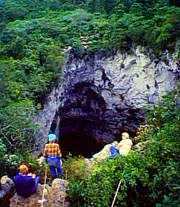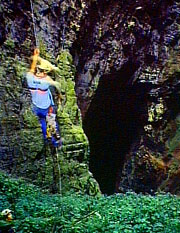The Archies Comeback Tour
Mexico 1985
At exactly 4:00 in the morning, I awake to find myself jammed with a ton of caving and camping gear in the back of a Nissan pickup, somewhere in south Texas. Through two panes of glass and the camper shell, I hear incredibly loud music --"99 Luftballons," by the German singer Nina--coming from the cab. Riding up front are Larry Johnson, Melissa England, and Joe Douglas. The year is 1985, it's the day after Christmas, and we are Mexico-bound.
Already we're deep into the romance of our escape, the youthful vision of a vehicle speeding down a highway with absolutely nothing in front of it but open road. Whether you're a caver or an outlaw on the run, that open road leads inevitably to Mexico, a promised land of gigantic caves, cheap hotel rooms, and free-flowing beer.
In Brownsville, we join forces with Greg Arrington and Buddy and Doranne Lane before crossing the border into Matamoros. This is a slow process involving a couple of hours of standing in line, filling out forms, and handing dollar bills to the appropriate Mexican Customs officials. Then we're off into the insanity of Matamoros traffic, where there are no signs, no lanes marked on the road, and only the strongest of motorists survive. We end up southbound on Highway 101, a narrow, bumpy strip of aging pavement with plenty of one-lane bridges, overloaded buses doing eighty miles an hour, and the occasional broken-down truck around a blind corner. Wooden crosses stand at intervals along the road, enshrining the spots where less fortunate travelers perished. Occasionally there is a large group of them evidently a bus accident. As we pull in to gas up at a state-owned PEMEX station in the town of Victoria, a crowd of barefoot young boys ignores the Nissan and gathers around the Lane Blazer, desperate to wash a windshield or sell a trinket. These kids recognize money when they see it.
On we go, with Melissa talking non-stop about her sorority at MTSU and her spring break plans. Johnson plays the stereo at a level high enough to start nuclear fission, alternating between "99 Luftballoons" and a new album, The Archies: Their Grooviest Hits, which he had happened upon at the Brownsville K Mart. After eight memorable, bumpy hours, we finally arrive at Hotel Valles, a legendary place of refuge for American cavers. The hotel offers clean rooms, beautiful courtyards, and an excellent restaurant for about $8.00 a night. We are now only about an hour's drive away from some of the most famous Mexican pits and caves.
After an excellent breakfast the next morning, we drive south to the town of Aquismon to obtain permission from "El Presidente," the provincial governor, to visit the caves in the area. Just a couple of years previously, this pretty village had been the start of a nine mile hike to the famous pit Golondrinas, which can now be reached by road. We take this same road into the mountains and soon park just a 20 minute walk away from Hoya de Guaguas (pronounced "Ooy-yah day Whaa-Wass," or rather "Hoya de Walrus" if you happen to be Gerald Moni).
As we hike toward the pit, it quickly becomes clear that something is wrong with Greg. Joe and I are the first to notice this. Despite the fact that we have loaded him down with 700 feet of rope and other gear, Greg never seems to get tired. He never even gets out of breath.
"What do you do to stay in shape?" I ask him.
"Oh, I run a little," he says. Turns out he also swims a little, bikes a little, rows a little--the man is a human fitness machine.

Hoya de Guaguas is one of the most impressive holes I've ever seen--never again will Valhalla and Neversink look big to me. The entrance, cut into the side of the mountain, must be 200-300 feet across, with a 700 foot drop on the high side. Feeling less ambitious, we rig the low side, which offers a mere 400 feet or so of glorious freefall. Once on rope, people descend until they simply disappear into insignificance. The sloped bottom of the pit is covered in chest-high greenery. A steep hike to the other side of the bottom leads to a gaping passage which slopes down to an additional 500 foot drop. As we're coiling the ropes, Larry Johnson has an encounter with malamujar ("malla moo-hair"), an innocent looking plant similar to stinging nettle--except with a much stronger sting. The name literally means "bad woman," and Larry assures us she's not a woman with a gentle touch.

We camp that night near the town of Xilitla at "The Birdhouse," the ruins of a bizarre, sprawling home built decades ago by Edward James, an eccentric British millionaire who came to Mexico to live with parrots and search for Utopia. In any case, the jungle long ago took possession of this unfinished palace. There are gigantic concrete mushrooms, circular doorways and colored monuments, waterfalls, swimming holes and diving platforms, a spiral stairway that goes forty feet up to nothing. It isn't possible to visit the interior of the house--squatters armed with machetes have taken up residence--but we walk around the perimeter for an hour or more, amazed.
The next morning, with all four of us crammed up front in the cab of the Nissan, we cruise around the Xilitla square. Johnson has the Archies blaring.
"Aw, Sugar...
Aw, honey-honey!
You are my candy girl,
And you got me wanting you!"
I try to slide lower in my seat, but there isn't room. People stare after us, no doubt impressed by the delicate intricacies of American bubblegum music presented at 150 decibels. Johnson is enjoying himself so much we miss the turn and have to go around the square another time, just to be sure everyone saw us.
We continue west towards the town of Jalpan, over twisting mountain roads where pickup trucks with twenty or thirty people hanging off the back are a common sight. We pass villages where huts made of sticks and mud surround towering, ornately decorated cathedrals. That night, we camp on the side of a gravel road. While the others stay in the vehicles, Joe and I sleep on the open ground, imaginations working overtime in anticipation of the deadly Bushmaster snakes which Buddy assures us are extremely common in this area.
Early the next morning, having proven Buddy wrong, we continue down the road towards our next stop: El Sotono, which means simply "the pit." When originally explored by Americans, this shaft was a two-day hike from the highway. Now the gravel road to Rancho Barro brings cavers to within a couple hours of the pit. We top a rise in the road and the mountain looms before us, still miles away but with an incredible hole clearly visible in its forested upper slopes. It looks to me like a red hot meteorite a quarter mile wide punched a hole right into the mountain.
The road ends abruptly at the school in Rancho Barro, where curious young boys quickly surround us. The girls, like many women in Mexico, tend to be much shyer, keeping their eyes low and ducking quickly behind cover at the first sight of a camera; but they, too, are watching in what we have come to call "The Indiana Jones Syndrome." It's pretty obvious that we're from out of town. Only Larry, with his dark, rounded face and black hair, looks as if he belongs. The longer he stays in Mexico, the more Johnson looks like a native. Joe and I have taken to calling him "Lorenzo" and are privately wagering whether U.S. Customs will let him back across the border without a green card.
While the curious continue to look on, we arrange for burros to carry our 1500 foot rope, water, and equipment the three miles up the pit. "Un precio," Joe keeps insisting, one price. Burro drivers have been known to negotiate a roundtrip fee in advance, and then demand more when it comes time to bring the equipment down. It isn't honest, but can you blame them? We come driving into their village in fancy four wheel drive trucks like Cortez came into Tenochtitlan, rich gringos on holiday. The only thing that saves us, Joe says later, is that most of these people don't understand the disparity between us. If they knew how rich even the poorest of us is by their standards, the homes we live in and the conveniences we take for granted, they might not greet us with the friendly smiles we've encountered so far.
The price negotiated, the burros expertly loaded, we follow the animals on a steady, hot climb, about equal to doing the Ellisons hike three times over. Greg, having paid his share for the burros, insists on carrying all of his gear, and promptly takes the lead. Halfway up the mountain, our guide from the village stops the burros at a rock where a natural depression has captured a tiny pool of water. Taking an old tin can from under the leaves, he offers us a drink, but we decline. We are all carrying canteens full of water, and I'm left feeling that we should have offered him a drink instead of the other way around.
Seen from the edge, El Sotono is a void so immense it appears more a circular cliff than a pit. From the high side, the drop would be over 1300 feet. We rig at a more feasible location where the drop is around 1200 feet, nearly all of that freefall. One by one, everyone but Joe, Melissa and I descends. Greg, still fresh after his brisk hike up the mountain, climbs out in about 30 minutes. Johnson is the last to go, making his climb out in the moonlight. At sunrise, Joe wakes me for a quick breakfast. It's our turn. With the sun just peeking over the mountains, he rappells down fifty feet of slope, then disappears over the edge of the deepest pit in the world. I'm still half asleep, and have to go back to the tent twice for things I've forgotten. But when I finally back over the lip, I wake up quickly. This is a pit with some elbow room! Unlike Golondrinas, where the rope comes down the middle of the shaft, at Sotono one tends to stay fairly close to the wall. I drop at high speed into the void, my ears popping halfway down.
I find Joe sitting at the top of a long slope of loose gravel. Much of the bottom of the pit is a sort of jungle, filled with small trees and malamujar. There seems little hope of finding the register, so Joe and I rig in and start climbing. To my amazement, I see bolts placed at intervals along the wall, and wonder, did someone do El Sotono using rebelays, or am I hallucinating?
After walking down the mountain with the burros--thankfully, without being extorted--we start the long drive back to Hotel Valles for New Years Eve. Halfway back to Valles, Johnson gets bored.
"I've got an idea," he says. "Now just suppose I were to close my eyes here for about a minute, and you tell me which way to turn the wheel."
"Larry," I say, "I don't think that's a good idea."
"Okay, got 'em closed. Now, wasn't there a curve coming up? Let me know if start to slow down."
He's joking, I think. He has one eye cracked open, or something. Just then, the tires on my side drop off the edge of the pavement.
"To the right!" I say. "No, not that much! My God, Larry, open your eyes!"
But he doesn't open his eyes. We veer erratically down the road until Johnson is satisfied that a full minute has passed. If he has been joking, he doesn't let on. Instead, he pops in the Archies and stretches against the seat in obvious satisfaction.
Miraculously still alive, we reach the hotel, where our friend Tomas eagerly greets us. Of all the Hotel Valles staff, Tomas is our favorite, because he speaks the best English. Tomas informs us of a "very big fiesta" in the dining room. There will be a gourmet meal, champagne, and music. It sounds great. After a much-needed shower, we gather around 9:00 p.m. outside the main dining room, and are quickly ushered towards a table right up front. Only then, as we parade past a room full of suits and tuxedos, do we realize that this is a formal affair. The mayor, all the local officials, perhaps even El Presidente himself, is here, and we sit in full view of all of them, dressed in our best t-shirts.
The band plays a series of spirited songs, including my personal favorite, "Nueva York, Nueva York." Then, out of nowhere, comes a moment of crisis. The band has left the stage and is moving among the tables, serenading. They stop at our table and ask for a request. None of us knows a thing about popular Mexican music. It seems to me that everyone in the room is looking at us. The five musicians stand there, waiting.
"I've got one!" Johnson blurts. "The Frito Bandito song!"
Fortunately, the band has a sense of humor. They don't have us thrown out into the street, but instead go into a slow, soulful rendition of the classic Mexican love song known to ignorant Americas only as the theme to the Frito Bandito.
The last cave we visit is El Abra, which has a large entrance visible from the road. A steep hike up the hill takes us into a huge, decorated passage worthy of Carlsbad. Five hundred feet back, the passage intersects a beautiful green shaft at a ledge 80 feet off the floor. Three hundred feet above us, daylight streams in from another entrance.
At Victoria, the four of us in the Nissan depart from Lane and Company and head for the sprawling, smoggy city of Monterrey, hoping to tour the Garcia Caves, a commercial operation just outside town. After stopping for a tour of a waterfall along the way, we arrive a bit later than planned. An impressive incline railway leads a mile or so up to a huge entrance in the side of a cliff, but the last tour of the day has just departed. It's time to go home.
As we near the border town of Nuevo Laredo, Johnson becomes obsessed with the idea of spending the last of his pesos on a grand Mexican dinner before we leave the country. Lost on the confusing, unmarked streets, we suddenly find ourselves headed down a one-way boulevard towards the stark gateway of Mexican Customs.
"Look out!" Johnson cries, yanking at the wheel. "Gotta turn around. No! We'll cross the border, then come back. Wait, let's not cross!"
Johnson is steering the truck around and around in circles in the road just before the gate. I can see Mexican Customs officials watching with great interest. When we finally stop going in circles and drive up to the gate, they wave us quickly on, no doubt eager to see us out of their country. The bright sodium lights of American Customs, far more ominous, loom ahead of us. Unsmiling officials direct us to pull over and park.
"I wish I could get some pictures of this," I lament. "Crossing the border is a big part of the Mexico experience."
"Sure you can get pictures!" Johnson exclaims. "You're in the United States of America. It's a free country!"
I get out my camera. A Customs official is instantly at my side. "No pictures," he says, then proceeds to make us unload the entire truck in front of him.
The delay is minor one. We're back in America, the home of fast food, convenience stores, and mind-numbing Interstate highways, where the biggest challenge is staying awake. The cab of the truck is strangely silent. After a week on the road, even Melissa is talked out.
Johnson's head starts nodding, but he refuses to give up the wheel. To compensate for his fatigue, he slows down. The more sleepy he gets, the slower Larry drives. We've got a thousand miles to go, and we're doing all of 30 MPH on the Interstate.
"You know," Larry says, perking up, "we're not all that far from the Devil's Sinkhole. Suppose we took an extra day and drove over there?"
Suddenly we're young, we've got the Archies in the tape deck, and all the time in the world.
Photographs:
Hoya de Guaguas from the High Side
Hoya de Guaguas from the bottom of the 400 Foot Side
Water |
Caving |
Hang Gliding |
Backpacking |
About
![]()

Copyright © 1996-2013 by Rodger Ling.
All rights reserved.





